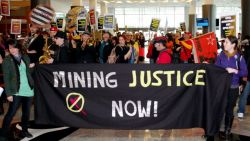Vancouver
The Business of Gold in Guatemala
Amnesty International Film Festival

7:00pm
Samedi Novembre 19 2011
Following info. is from straight.com (see link above)
A documentary by Grégory Lassalle and Marcos Pérez. In Spanish with English subtitles. Unrated. Plays Saturday, November 19, at the 16th Annual Amnesty International Film Festival, SFU Harbour Centre, Room 1700, 7 p.m.
Since the advent of free-trade agreements in this hemisphere, mining exploration and mine projects have boomed, especially in Central America. Governments in Guatemala, El Salvador, Honduras, and Costa Rica have been especially encouraging to foreign-owned mining companies, and gold-mining, in particular, was high on the wish list of those companies, many of which were Canadian-owned (and with several of those headquartered in Vancouver).
According to Natural Resources Canada, Canadian mining companies spent $1.6 billion in Central America in 2006, up from $41 million in 2002. But the sometimes lax attitude of regional governments to environmental standards and the health and well-being of their indigenous populations has resulted in widespread backlashes against foreign-owned mining companies, especially because of the practice of cyanide leaching used by most gold-mining operations.
After years of genocidal attacks against its mostly rural Maya population, the Guatemalan government busied itself in the mid-1990s by giving away hundreds of mining concessions to foreign companies in exchange for a measly one-percent tax on profits.
The Business of Gold in Guatemala chronicles the development of a combined open-pit and underground gold mine (the Marlin Mine) in two highland Guatemalan municipalities, San Miguel Ixtahuacán and Sipacapa (primarily in San Miguel), its effect on the surrounding Maya communities, and their reaction to what they claim are dried-up and contaminated water sources (the mine uses 200,000 litres of water per hour), social ills, health concerns, and intimidation by mine backers. The mine is owned and operated by Vancouver-based Goldcorp through a subsidiary, Montana Exploradora de Guatemala, S.A.
This 54-minute documentary isn’t as polished as, say, Goldcorp’s efforts to build good PR back home ($25 million to the University of Ottawa by then-Goldcorp chair Ian Telfer in 2007, $5 million to UBC in 2010, and a controversial $10-million donation to SFU’s new downtown arts complex a year ago), but it doesn’t need to be.
The voices (and tears) of the Maya people, and the reaction of the entrenched interests and their security apparatus, are sufficiently eloquent to convey its message.
A segment featuring freelance journalist Dawn Paley—in which she asks passersby in Vancouver if they know where their Canada Pension Plan funds are invested ($256 million in Goldcorp shares alone)—illustrates why Canadian mining companies can operate virtually with impunity outside of our borders: domestic ignorance of their activities and sources of funding. B.C. public-sector unions have $280 million invested in Goldcorp, and the combined financial commitment of public and union pension funds to the company in this country totals almost a billion dollars.
(And, yes, the irony of this film being shown in SFU’s downtown Harbour Centre is not lost on this reviewer.)
The site for the Vancouver local of The Media Co-op has been archived and will no longer be updated. Please visit the main Media Co-op website to learn more about the organization.